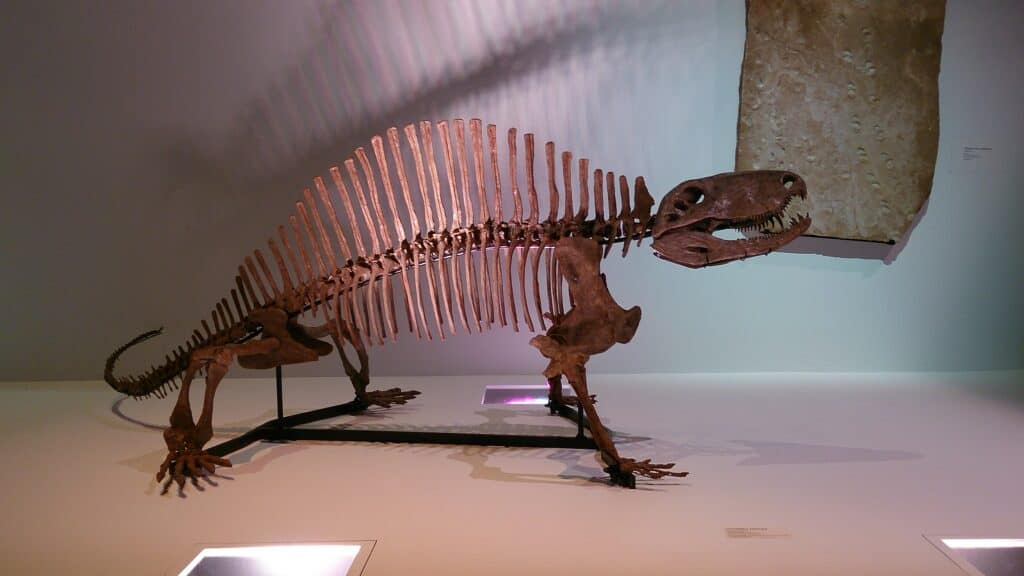Crocodiles are essentially the dinosaurs of the modern era, and they’ve been around for quite some time! Still, there are creatures that predate even these living fossils, even if they look quite similar. Today, we are going to learn about one of these creatures. Incredibly, these crocodile-like animals may just be the ancient ancestors of all modern-day mammals (like you and me)! Let’s meet the pelycosaurs!
Ancient Ancestors of Modern-Day Mammals

Pelycosaurs closely resembled crocodiles.
©Pearson Scott Foresman, Public domain, via Wikimedia Commons – License
Pelycosaurs are an extinct group of creatures that closely resemble reptiles, but are some of the earliest branching members of the group that aren’t technically classified as such.
Essentially, Pelycosaurs look like reptiles, but they distinctly split away from other reptiles and later evolved into modern-day mammals. The best way to think about Pelycosaurs is as a middle-man between reptiles and mammals.
Pelycosaurs first appeared as the earliest synapsids, a group of animals that are defined as having a single opening behind the skull where muscles attach. This trait isn’t shared by the other split-off, a group known as sauropsids. Sauropsids, more famously, is the group that gave rise to modern-day birds and reptiles.
How Big were Pelycosaurs?
Pelycosaurs were a diverse group with many different species within. The largest members of the group could get pretty big, with some growing up to 10 feet or more. Other members of the group were probably smaller, however, and ranged between 1 to 8 feet long.
Where were Pelycosaurs discovered?
Pelycosaurs ranged across much of the earth. Back when they were around, the earth would have also looked quite different. Still, scientists have mostly found Pelycosaurs fossils in a few specific regions. The most common Pelycosaurs fossils are usually found in Europe and North America, but later versions of Pelycosaurs (and much smaller ones) have also been uncovered in Russia and South Africa.
When were Pelycosaurs around?

Pelycosaurs lived around 308 million years ago.
©Kim Alaniz, CC BY 2.0, via Wikimedia Commons – License
Pelycosaurs are an extremely old group of animals, and none have survived to this day. The first Pelycosaurs likely came on the scene around 308 million years ago, 50 million years before the first dinosaurs ever set foot on the earth. The last of the Pelycosaurs lived around 260 million years ago, about 10 million years before dinosaurs roamed the earth.
The temporal range of the Pelycosaurs was from the Pennsylvanian to the Capitanian. What’s rather incredible, however, is what happened after Pelycosaurs disappeared from the earth. Although they officially went extinct 260 million years ago, the evolved descendants of their group continued on and are known as therapsids. Today, only one group of therapsids are left, and they are classified as mammals! Incredibly, all living mammals (including humans) can trace their ancestry back 250 million years to a group of pre-mammalian creatures that looked like strange crocodiles. As crazy as it sounds, we have the fossils to prove it!
Some of the most famous Pelycosaurs

The Dimetrodon had a massive sail-like spine across its back
©Dziurek/Shutterstock.com
Pelycosaurs are a group of animals, not a single species. Still, many people have encountered popular imagery that includes Pelycosaurs, even if they didn’t know it at the time. In fact, there are some commonly used depictions of famous Pelycosaurs that can be found in movies like Jurassic Park, even though they technically aren’t dinosaurs.
One of the most popular genera of Pelycosaurs is the Dimetrodons. Dimetrodons resemble squat crocodiles and are easily identified by their massive sail-like spine across the backs. The last Dimetrodon lived 60 million years before the first dinosaurs ever lived, although they look extremely similar to most people. You can see Dimetrodons in the most recent Jurassic World movie in the cave system near the end of the film.
While the Dimetrodons are the most famous of the Pelycosaurs, they aren’t the only ones that are occasionally depicted. Other well-known examples include:
- Sphenacodon
- Edaphosaurus
- Ophiacodon
What did Pelycosaurs look like?
First, it’s important to remember that not all Pelycosaurs looked the same. Still, there are most definitely some traits that most of them shared. Generally, Pelycosaurs were between 3-10 feet long and had a body shape similar to a modern-day crocodile or alligator. They would have had skin, not scales, but the skin would have been covered in bony scutes. A few of the clades within the Pelycosaur group had tall sails (like Dimetrodon), although this wasn’t present in all of them. It’s believed that the sails acted as a thermoregulation organ or potentially as a way to attract a mate.
Up Next:
- Discover 12 Extinct Animals That Lived in Oklahoma
- Meet Every Dinosaur Featured in Jurassic World Dominion (30 Total)
- Meet the 7 Most Famous Dinosaurs From Jurassic Park
The photo featured at the top of this post is © Kim Alaniz, CC BY 2.0, via Wikimedia Commons – License / Original
Sources
- Wikipedia, Available here: https://en.wikipedia.org/wiki/Pelycosaur
Thank you for reading! Have some feedback for us? Contact the AZ Animals editorial team.






